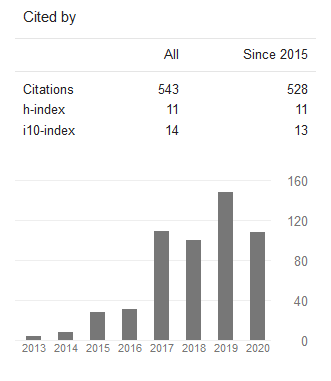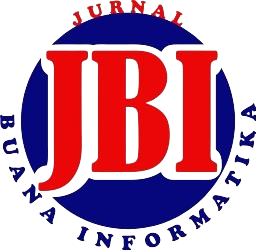Kombinasi Algoritma Spatial Autocorrelation G* dan Algoritma C5.0 untuk Deteksi Daerah Rawan Longsor di Pulau Jawa
DOI:
https://doi.org/10.24002/jbi.v9i2.1706Abstract
Abstract. Java Island is also an island with a high frequency of landslide natural disaster. Various efforts have been made to minimize the disaster risk, including the model compilation of early disaster detection at the areas with landslide potential. This research aims to develop an early warning model for landslide potential areas using Spatial Autocorrelation combined with Machine Learning Algorithm based on attributes of landslide causes. The first step is to classify areas in Java Island into a landslide hotspot and landslide coldspot using spatial autocorrelation G * algorithm. This algorithm revealed 124 polygons of sub-district in Java as landslide hotspots. The next step is building machine learning model using C5.0 method for hotspot and coldspot areas. In this research, we utilize landslide-causing attributes i.e. rainfall, land cover, area slope, soil type, and land movement. The hotspot model showed that landslide distribution focuses on land cover attributes. Meanwhile, for the coldspot area model, there is no focus of landslide distribution on one attribute. Furthermore, the accuracy level of hotspot model are 84.61% and 71.66% for coldspot model.
Keywords: Landslide, Machine Learning, Spatial Autocorrelation, C5.0, G*.
Abstrak. Pulau Jawa merupakan pulau dengan frekuensi bencana alam tanah longsor yang tinggi. Untuk meminimalkan resiko bencana, dilakukan penyusunan model komputasi deteksi dini daerah potensi longsor. Tujuan dari penelitian ini adalah membangun model deteksi daerah potensi longsor menggunakan Spatial Autocorrelation yang dikombinasikan dengan algoritma Machine Learning berbasis data variabel-variabel pemicu longsor. Tahap pertama yang dilakukan adalah mengklasifikasikan daerah-daerah di Pulau Jawa sebagai daerah hotspot longsor dan coldspot longsor menggunakan algoritma spatial autocorrelation G*. Dihasilkan 124 poligon kecamatan di pulau Jawa sebagai daerah hotspot longsor. Setelah diklasifikasikan, dibangun model machine learning menggunakan metode C5.0. Atribut-atribut pemicu longsor yang digunakan untuk membangun machine learning adalah curah hujan, tutupan lahan, kelerengan, jenis tanah, dan gerakan tanah. Hasil yang diperoleh dari model hotspot terlihat distribusi longsor memusat pada atribut tutupan lahan dan menghasilkan akurasi model 84.61%. Untuk model coldspot area tidak terlihat adanya pemusatan pada satu atribut pemicu longsor, akurasi untuk model ini adalah 71.66%.
Kata Kunci: Longsor, Machine Learning, Spatial Autocorrelation, C5.0, G*.
References
Badan Nasional Penanggulangan Bencana. (2017) Data Informasi Bencana Indonesia. [Online]. Tersedia: http://dibi.bnpb.go.id/
Badan Nasional Penanggulangan Bencana. (2017) Jumlah Kejadian Bencana Indonesia. [Online]. Tersedia: http://dibi.bnpb.go.id/data-bencana/crosstab
Badan Pusat Statistik. (2010) Data Sensus Penduduk Tahun 2010. [Online]. Tersedia: http://sp2010.bps.go.id/
M. S. Alkhasawneh, U. K. Ngah, L. T. Tay, N. A. M. Isa, & M. S. Al-Batah, “Modeling and Testing Landslide Hazard Using Decision Tree,” Journal of Applied Mathematics, vol. 2014, pp. 1–9, 2014.
M. S. Tehrany, B. Pradhan, & M. N. Jebur, “Spatial prediction of flood susceptible areas using rule based decision tree (DT) and a novel ensemble bivariate and multivariate statistical models in GIS,” Journal of Hydrology, vol. 504, pp. 69–79, 2013.
A. J. Myles, R. N. Feudale, Y. Liu, N. A. Woody, & S. D. Brown, “An introduction to decision tree modeling”, Journal of Chemometrics: A Journal of the Chemometrics Society, vol. 18, no. 6, pp. 275-285, 2004.
R. B. Kheir, M. H. Greve, C. Abdallah, & T. Dalgaard, “Spatial soil zinc content distribution from terrain parameters: A GIS-based decision-tree model in Lebanon,” Environmental Pollution, vol. 158, no. 2, pp. 520–528, 2010.
F. B. Wijaya, “Pendekatan Space Time Autoregressive (Star) dan Generalized Space Time Autoregressive (GStar) melalui Metode Autoregressive (AR) dan Vector Autoregressive (VAR),” Doctoral dissertation, Bogor Agricultural University (IPB), 2015.
D. A. Rudnick & S. J. Ryan, “The Role of Landscape Connectivity in Planning and Implementing Conservation and Restoration Priorities”, The Ecology Society of America, No. XVI, 2012.
D. M. Theobald, “Topology revisited: representing spatial relations,” International Journal of Geographical Information Science, vol. 15, no. 8, pp. 689–705, 2001.
Y. A. Susetyo, “Detection Model of Landslide-Potential Areas based on Local-Learning using Iterative Dichotomiser Three Algorithm”, International Journal of Computer Science and Information Security (IJCSIS), vol. 14 no. 9, September 2016.
G. P. Siknun and I. S. Sitanggang, “Web-based Classification Application for Forest Fire Data Using the Shiny Framework and the C5.0 Algorithm,” Procedia Environmental Sciences, vol. 33, pp. 332–339, 2016.
W. Yogi Yusuf, “Perbandingan Performansi Algoritma Decision Tree C5.0, Cart, Chaid: Kasus Prediksi Status Resiko Kredit di Bank X”, Seminar Nasional Aplikasi Teknologi Informasi 2007, pp. 59-62, 2007.
Peraturan Menteri Pekerjaan Umum Republik Indonesia No. 22/PRT/M/2007 tentang Pedoman Tata Ruang Kawasan Rawan Bencana, Departemen Pekerjaan Umum Republik Indonesia, 2007.
S. Y. J. Prasetyo, S. Subanar, E. Winarko, & B. S. Daryono, “ESSA: Exponential Smoothing and Spatial Autocorrelation, Methods for Prediction of Outbreaks Pest in Indonesia,” International Review on Computers and Software (IRECOS), vol. 10, no. 4, p. 362, 2015.
J. Chen & J. Jiang, “Analysis for spatial autocorrelation for point objects based on line buffer”, Proceeding of Accuracy 2010 Symposium, Leicester, UK, 2010.
J. K. Ord & A. Getis, “Local Spatial Autocorrelation Statistics: Distributional Issues and an Application,” Geographical Analysis, vol. 27, no. 4, pp. 286–306, Mar. 2010.
J. A. Lentz. (2009) Spatial Autocorrelation Statistic.[Online]. Tersedia: http://jenniferalentz.info/Teaching/StudyGuides/SpatialAutocorrelation.pdf
H. Bhalekar & S. Kumbhar, “Pre-processing data using ID3 classifier”, International Journal of Engineering and Techniques, vol. 1, no. 3, pp. 68-73, June 2015.
Pedoman Teknis Penyusunan Peta Status Kerusakan Tanah, Deputi Konservasi Sumber Daya Mineral Departemen Lingkungan Hidup Republik Indonesia, 2009.
D. L. Gupta, A. K. Malviya, & S. Singh, “Performance Analysis of Classification Tree Learning Algorithms,” International Journal of Computer Applications, vol. 55, no. 6, pp. 39–44, 2012.
M. S. Alkhasawneh, U. K. Ngah, L. T. Tay, N. A. M. Isa, & M. S. Al-Batah, “Modeling and Testing Landslide Hazard Using Decision Tree,” Journal of Applied Mathematics, vol. 2014, pp. 1–9, 2014.
T. Kavzoglu, E. K. Sahin, & I. Colkesen, “Landslide susceptibility mapping using GIS-based multi-criteria decision analysis, support vector machines, and logistic regression,” Landslides, vol. 11, no. 3, pp. 425–439, 2013.
Maridi & A. Saputra, “Role of Vegetation for Water and Soil Conservation in Watershed: Case Study in 3 Sub-Watershed of Bengawan Solo (Keduang, Dengkeng, dan Samin)”, Seminar Nasional Konservasi dan Pemanfaatan SDA, Surakarta, 2015.
Downloads
Published
Issue
Section
License
Copyright of this journal is assigned to Jurnal Buana Informatika as the journal publisher by the knowledge of author, whilst the moral right of the publication belongs to author. Every printed and electronic publications are open access for educational purposes, research, and library. The editorial board is not responsible for copyright violation to the other than them aims mentioned before. The reproduction of any part of this journal (printed or online) will be allowed only with a written permission from Jurnal Buana Informatika.
This work is licensed under a Creative Commons Attribution-ShareAlike 4.0 International License.










